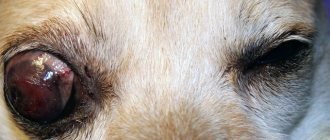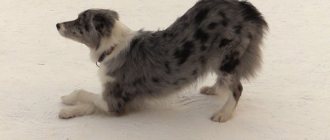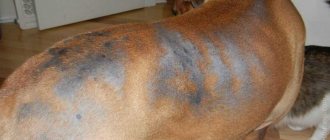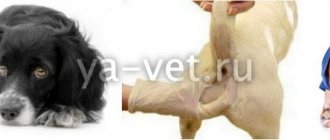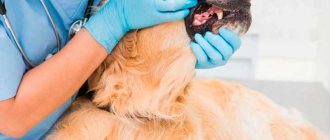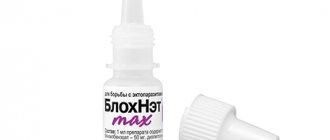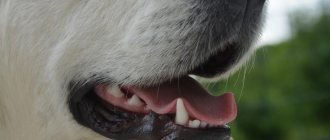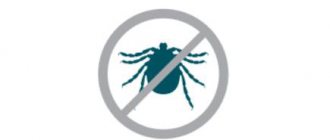What is gum disease
In veterinary medicine and medicine, inflammation of the gums is called “gingivitis”, from lat. Gingiva, which means “gum” in Russian. Many people do not consider this disease as something serious, but in vain.
To begin with, the gums themselves are the anchoring foundation for the teeth. If their inflammation is severe, the dog can very quickly become toothless. The absence of teeth will inevitably lead to dire consequences for the entire digestive system of the pet , because of which the dog will definitely not live long and well.
There are a lot of blood vessels in the oral cavity. Any focus of prolonged inflammation is a potential risk of sepsis. With advanced gingivitis, cases of death due to severe sepsis are far from uncommon.
Advice! It is necessary to monitor the condition of your pet’s gums, taking timely measures to treat their inflammation.
Causes of inflammation in dogs
The main causes of inflammation in dogs:
- Poor quality feeding when there is no vitamin C in the diet. Its lack, as many know, provokes the development of scurvy. With this disease, the gums become very inflamed, bleed, and teeth fall out en masse. Even though vitamin C is synthesized in the body of these animals, if the quality of the diet is very poor, the body may not have enough autogenous ascorbic acid. True, in veterinary practice such cases are extremely rare (but there are exceptions, which will be discussed below).
- Helminthic infestations. Worms are dangerous not only because they take away nutrients from the animal’s body. Due to the peculiarities of their metabolism, the body of the worms themselves needs a lot of vitamins, including ascorbic acid. And if there are too many parasites, the dog may develop symptoms of scurvy, even if its diet is perfectly balanced in all nutrients, macro- and microelements, and vitamins.
- If you give your dog “treats” in the form of chicken bones , there is a risk of both gingivitis and intestinal perforation from debris from this “food”. The bones split into small and very sharp fragments, often injuring the soft tissues of the entire gastrointestinal tract. Pathogenic or conditionally pathogenic microflora enter the wounds, provoking the development of inflammation.
- Infectious diseases of the digestive system. The causative agent of infection can be in any organ or tissue, including the soft tissues of the gums.
- Caries and other periodontal diseases. Inflammation and pathogenic microflora can easily spread to the gums.
- Tartar – inflammation of the gums is inextricably linked with it. The stone itself is petrified (i.e. petrified) dental plaque. It contains a simply terrifying amount of microflora. If you do nothing with the stone and do not remove it in any way, inflammatory processes will inevitably develop in the pet’s oral cavity.
List of gum diseases accompanied by inflammatory processes
Here is an approximate list of gum diseases accompanied by inflammatory processes:
- “Pure” gingivitis , i.e. native gum inflammation. It can develop due to any of the reasons described above.
- Periodontitis. This is the name of a disease (more precisely, a complex of diseases) in which the ligamentous apparatus of the tooth weakens, as a result of which the latter becomes loose and a gap appears between it and the gum. There food residues accumulate, first putrefactive and then inflammatory processes develop rapidly.
- Periodontal disease. Often this pathology is confused with the previous option, which is incorrect. In this case, the blood supply to the tooth tissue is disrupted, causing it to begin to decay, simultaneously “grabbing” the gums with it. The result is the same, i.e. severe inflammation and very likely loss of tooth/teeth.
Reasons for rejection
In addition to the quite obvious reason - injury, the dog's gums bleed due to illness. Moreover, many of them are not localized directly in its mouth. Such ailments are common and ulceration or erosion of the mucous membranes is one of their symptoms. The veterinarian may have the following conditions:
- Gingivitis is a secondary disease in which, for various reasons, the gums become severely inflamed with further spread to the pharynx and larynx.
- Tartar, localized along the gums, puts pressure on them and promotes the proliferation of microbes that cause inflammation and destruction of the mucous membranes.
- Stomatitis is a massive inflammation of the entire mucous membrane of the mouth, including the palate and tongue, caused by injury or infection.
- Caries, depending on its depth, can cause destruction of the gums around the affected tooth and, as a result, bleeding from them.
- Periodontal disease is a secondary bacterial disease characteristic of the tissues around loose teeth, poor hygiene, and complicated gingivitis.
- Hormonal pathologies affect the entire animal’s body, causing problems with metabolism and blood clotting and contributing to self-damage to tissues.
- Diseases of the nervous system can cause a dog to bite his gums, tongue, misalign his bite, and even wear his teeth.
- An allergy in which, due to severe inflammation, the mucous membrane is damaged and bleeding occurs.
- Immune disorders contributing to epidermal damage, poor healing and low blood clotting.
- A malocclusion in which the teeth actually puncture the gums.
Suspecting a particular diagnosis only on the basis of an independent home examination risks missing the real cause of your pet’s condition. Dental ailments are not noticed immediately, so the animal usually gets to the doctor when their condition has worsened somewhat. The pet cannot complain, but there is no point in doubting that he is experiencing discomfort due to the swollen tissues around the teeth.
Treatment will be carried out both general and local, because in addition to healing the damaged area, general healing of the body will also be required. It is possible to take antibiotics, since the wound environment is very susceptible to infection. It is because of them that even a tiny scratch that would heal on the skin in 1 day causes the dog’s gums to bleed. The fact that one area initially suffers deceives many owners. The diseases mentioned, for example, gingivitis, stomatitis and periodontal disease, tend to spread further and further in the absence of comprehensive treatment.
Symptoms and first signs of inflammation in the gums
Veterinarians identify the following symptoms and first signs of an inflammatory process in the gum tissue:
- Sharp, sudden loss of appetite. At the same time, it is clear that the dog wants to eat (even very much), but cannot. When chewing food, severe pain occurs, causing the pet to throw away the half-eaten piece, whining and moaning. Thirst remains at the same level.
- Unpleasant odor : inflammation of the gums is always accompanied by its appearance, and in some cases the dog’s mouth smells simply disgusting. This is due to putrefactive processes, and the “aroma” is also characteristic of particularly severe forms of the inflammatory process.
- A brownish-gray plaque can be seen on the teeth and gums.
- Redness and severe swelling of the gums. In this case (in severe cases), when they are shaken, the teeth clearly wobble in the gums, and a small amount of blood or exudate may be released.
- Small ulcers may appear on the lateral surfaces of the gums themselves.
- A sharp increase in salivation.
Redness and other symptoms
The owner can suspect inflammation of the gum mucosa in a pet by paying attention to the following clinical signs:
- The animal is reluctant to eat its favorite food. The dog approaches the plate, but eats little or refuses to eat at all. In severe cases, anorexia may develop.
- Increased salivation. This symptom is especially difficult to notice in breeds with a brachycephalic skull structure, characterized by folded jowls.
- The animal does not allow its mouth to open and shows aggression when trying to examine the oral cavity.
- Due to inflammation of the soft tissues, an unpleasant putrid odor is detected from the pet’s mouth.
- When examining the mouth, redness of the gums is observed. In some cases, you may notice bleeding and the presence of ulcers on the mucous membrane.
- Inflamed gums are swollen.
- With gingivitis, there is a change in the color of the teeth.
- The animal quickly loses weight.
In advanced cases, the dog may experience discharge of purulent contents when pressing on the affected gum.
Purulent form of inflammation
The purulent form of inflammation is noticeably more severe than others, and very dangerous complications are possible (even death). This type of gum damage is characterized by the following:
- Upon visual examination, purulent lesions of the gum mucosa, abscesses, ulcers, etc. are often noticed.
- The animal's gums become very swollen and swollen; palpation reveals pain. In this case, the dog may react inadequately; he must be very well secured during the examination!
- On examination, exudate will be visible. As a rule, purulent inflammation of the gums is accompanied by the release of a large amount of liquid, whitish-yellow pus.
- An increase in not only local, but also general body temperature. Sometimes there is a fever of a constant or intermittent type.
- In the most severe cases, a decrease in body temperature is observed, and in such situations the animal must be immediately taken to the clinic. It is very likely that the pet has developed sepsis, and without qualified veterinary care he will not live long.
Methods for treating gum disease in dogs
All methods of treating gum inflammation in dogs include the following procedures:
- Rinsing the oral cavity with solutions of astringents and disinfectants.
- If the dog has tartar (and with gingivitis it often does), it must be removed. This can be done either through mechanical removal or using ultrasound and special chemicals.
- Since inflammation in this case is always a consequence of the activity of pathogenic and conditionally pathogenic microflora, the animal must be prescribed antibiotics and other antimicrobial agents.
- In severe cases, it is necessary to remove teeth , as well as excise and sew up the affected tissue directly in the dog’s oral cavity.
- Anticoagulants and enzyme inhibitors are prescribed. Without this, the healing of ulcers and foci of inflammation will slow down significantly (there are more than enough enzymes in the oral cavity).
- You will definitely need multivitamins.
- During the treatment period, the animal is completely transferred to soft food , since the dog will not be able to fully chew and digest solid food.
Treatment methods for gingivitis
Gingivitis should be treated when the first symptoms appear. There is no need to wait until the dog starts whining and refuses to eat.
Before you take your pet to the clinic, you can relieve his suffering at home. Rinse the affected areas of the mouth with a decoction of chamomile or calendula. If there are no medicinal herbs at home, baking soda dissolved in a small amount in water will relieve the pain. Regular rinsing will slow down or completely stop inflammation.
You will have to give up solid food - inflamed gums can easily be injured. But even after the dog eats soft food, it will need oral hygiene. A decoction or solution can be poured into the mouth from a syringe or applied to a napkin and wiped over the teeth.
If ulcers appear in your pet's mouth, they should not be cauterized. This will cause more pain and will not stop the infection.
Veterinarians prescribe a course of treatment, which includes antibiotics and rinse solutions. The dosage and duration of use depend on the age, weight and condition of the dog. You should not choose medications on your own, so as not to harm the animal even more.
Antibiotics
- Amoxicillin. Sold in pharmacies.
- Baytril. Can be found in veterinary pharmacies and pet stores.
- Kobaktan. There are 2 forms: preparation powder and syringe. Sold in veterinary pharmacies.
Antiseptics
There are 3 types of oral medications.
| Focus | Name | Result |
| Anti-edema | Maraslavin | They remove the tumor. |
| Polyminerol | ||
| Copper sulfate | ||
| Anti-inflammatory | Heparin | Strengthens blood vessels, reduces their absorption capacity, and improves blood circulation. |
| Contrikal | ||
| Trasylol | ||
| Recovery | Keratolin | Heal wounds and accelerate the appearance of new cells. |
| Sea buckthorn oil | ||
| Phytodenitis |
Doctors recommend Argumistin, an antiseptic based on miramistin with the addition of silver. It helps heal cracks and develop immunity. The course of treatment with the drug is from 10 to 12 days.
Vitamin therapy
After an illness and a course of antibiotics, the dog’s body is weakened and requires care. To restore strength to your pet, doctors recommend vitamin complexes Vetomyun or Vetaxin, produced by. These preparations contain vitamins important for recovery: C, P, PP, group B.
Physiotherapy
- Gum massage;
- Electrophoresis with heparin - using a weak current, a medicine is injected into the damaged tissue, which improves blood circulation;
- Thermocoagulation of gums - dilation of blood vessels with a drug.
If gingivitis has entered the acute stage and the gums have begun to fester, you cannot do without the help of a surgeon. The operation to cleanse teeth of pus is called gingivectomy.
List of drugs, gels and antibiotics
Many medications are used to treat gingivitis. Below we provide an approximate list of drugs, gels and antibiotics that are most often prescribed in veterinary practice and allow us to achieve the best therapeutic effect:
- Antibiotics are prescribed from the group of cephalosporins (Ceftriaxone). In some cases, specialists also prescribe Amoxicillin and Cobactan.
- To relieve swelling of the gums, copper sulfate is used, as well as Polymenerol (or Polytacan). In medicine, these solutions are used for rinsing, but veterinarians and owners of sick pets have to use them to rinse the mouth of dogs.
- Heparin and Trasysol. They improve the condition of blood vessels and accelerate the healing process of damaged gum tissue.
- To speed up regeneration, natural sea buckthorn oil can also be used. It is used in the form of applications on inflamed gums, leaving for 10-15 minutes. During this time, the dog is occupied with something so that it does not eat or drink anything.
- Vetomune and Vetaxin can be used as multivitamins.
- Dental gels can be used to relieve pain and speed up the healing process. The most commonly used are Parodontotsid, Metrogyl denta, Cholisal. We recommend using medications in the form of gels, since this dosage form is much more reliably fixed on the surface of the gums and provides a pronounced, long-lasting therapeutic effect.
- To wash a dog's mouth, use a decoction of oak bark, chamomile, sage and yarrow. These are natural and fairly safe products that have an astringent and anti-inflammatory effect.
Safe Reasons
A dog’s oral cavity is exposed to various types of damage throughout its life, which can cause bleeding gums:
Changing teeth. The most common reason why puppies of all breeds may bleed from the gums. Unfortunately, it is impossible to predict this process, since in some animals the change of teeth is absolutely painless, while others suffer from swollen and reddened gums. In severe cases, the puppy may be prescribed painkillers and mouth rinses with antiseptics. It may also be necessary to remove baby teeth using tweezers.- Injury. The cause should be looked for in sticks, toys or food that the dog can injure his gums on. It usually heals on its own within a few days. If the wound is deep, blood may periodically ooze from it. Just in case, you can pour chamomile decoction into your pet’s mouth from a syringe to relieve/prevent inflammation.
- Foreign body. No dog can avoid getting a foreign object stuck in its gum. Most often these are chips from sticks, which they diligently try to chew. Small bones or pieces of toys (if they are made of low-quality plastic) can get stuck in the gums. The affected area bleeds constantly and may swell. The animal begins to have problems chewing food. Here the problem can be solved only by removing the foreign body from the gum.
- Age. The most unpleasant but inevitable cause of bleeding gums in an old dog. The older the pet, the more problems with the oral cavity. Growths may appear on the gums, teeth begin to loosen, rot and even fall out. This process cannot be stopped, you just need to come to terms with it and try to make life as easy as possible for your pet by rinsing the mouth with special antiseptic solutions and anti-inflammatory decoctions.
All the reasons described above (except for aging) do not pose a danger to the animal and can be successfully localized at home without consequences in the future.
Diet for feeding a dog with gingivitis
We already wrote above that the diet of a dog with gingivitis is enriched with soft foods that do not require effort to chew. Experienced veterinarians recommend using special holistic treatments for these purposes:
- DH ST/OX DENTAL HEALTH from Pro PLAN.
- Similar lines from Acana, Royal Canin, etc.
The only problem is the availability of all these diets. And we’re not even talking about price here: in many small towns (not to mention other populated areas) you simply can’t buy them. Therefore, they use the following food:
- In the most severe cases, when the dog cannot chew at all, it is given children's meat and meat and vegetable purees. There is no need to chew them, the dog will not experience pain.
- When your pet’s condition improves slightly and touching the gums does not cause him severe pain, you can switch to boiled chicken and rabbit.
- Up to four times a week, the dog can be given low-fat cottage cheese (not cottage cheese, but cottage cheese).
- Also, to improve digestion (and it will certainly be impaired), low-fat kefir or natural yogurt (without dyes and flavors) is given up to three times a week.
- Once a week – boiled, low-fat sea fish. Vitamin A contained in it accelerates regeneration processes.
Finally, after about three weeks from the start of treatment, the dog is gradually transferred to his usual diet, but for two months from the moment of recovery, we would advise not to use dry food.
Preventive measures for gum disease
The following gum disease prevention measures will help prevent the development of gingivitis:
- From time to time, the dog is given “bones” from pressed veins, as they help to naturally clean the teeth and gums.
- If the animal's diet consists mainly of canned food and natural food, it is necessary to examine the pet's teeth at least once a week. If there is a large amount of yellowish coating on them, it must be removed. To do this, wrap a piece of gauze (bandage) around your finger and, after dipping it in a weak soda solution, remove the dirt. If we are talking about small breed dogs, then this should be done weekly (they are prone to dental diseases).
- Treat your dog for worms in a timely manner.
Useful video
For information on what and how to brush your dog’s teeth, watch this video:
Similar articles
- Why does a dog smell (strongly like dog, fish, mice...)
Inflammation of the gums, caries, periodontitis, injuries and bruises of the jaw are often the cause of a disgusting smell from a dog’s mouth. Read more - Gastritis in dogs: symptoms, types - acute, chronic...
The chronic form of the disease develops when rules and regulations of feeding are violated, teeth and gums are diseased. ... Inflammation of the gastric mucosa in dogs is due to many reasons, the main one of which is an error in ... Read more
- Salmonellosis in dogs: first symptoms, analysis...
Inflammation of bones and periosteal tissues or osteomyelitis in cats: what... Unexpectedly detected arthritis in cats is not a reason to panic, but... ... We recommend reading about pneumonia in dogs. Read more
- Osteomyelitis in dogs: symptoms, treatment
Tuberculosis of tubular bones is the most common infectious disease leading to the development of purulent inflammation of bone tissue in dogs. ... Pneumonia in dogs: symptoms, treatment, antibiotic... Marina (content manager). Read more
- How to treat a dog’s wound, treat purulent, lacerated...
How to treat a broken paw in a cat. Inflammation of bones and periosteal tissues or osteomyelitis in cats: what... ... Severe disease of the reproductive system - pyometra in dogs: signs, types, therapy. Read more
